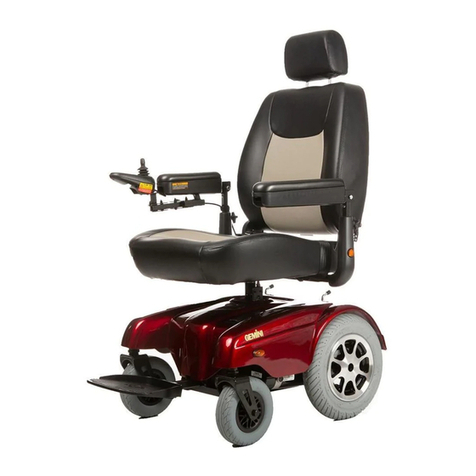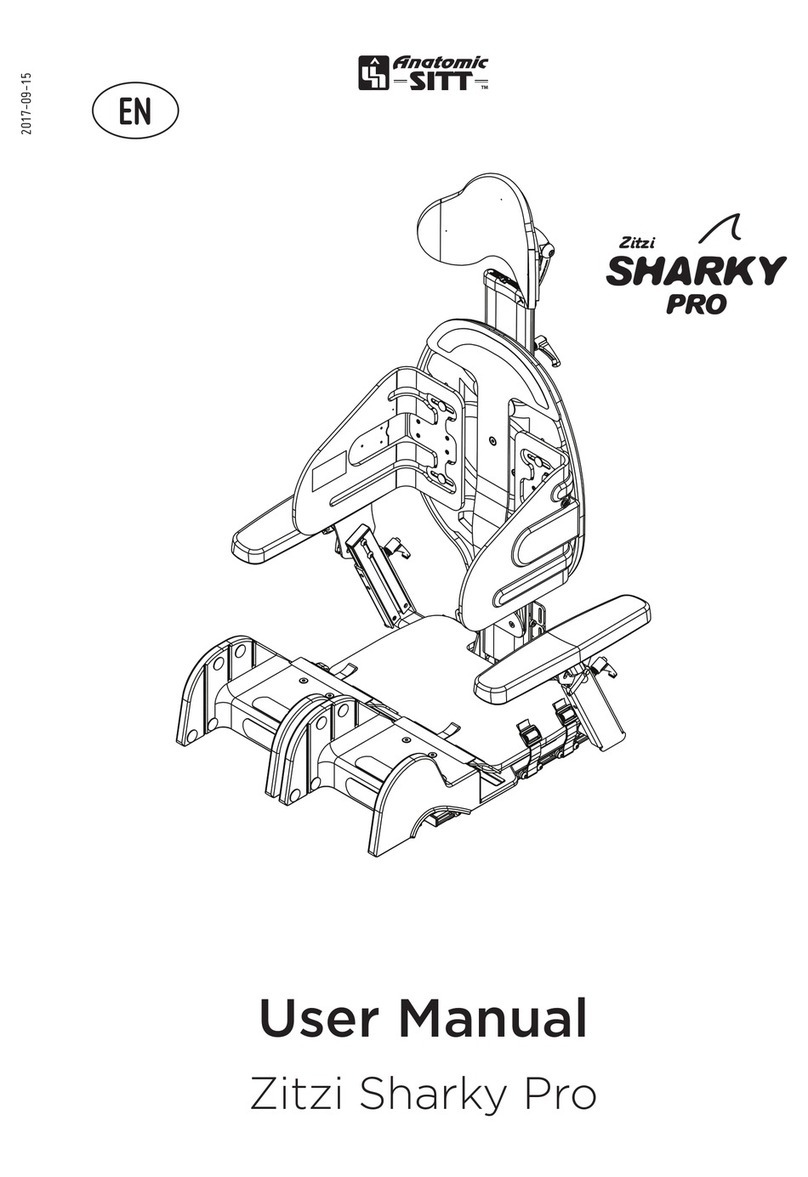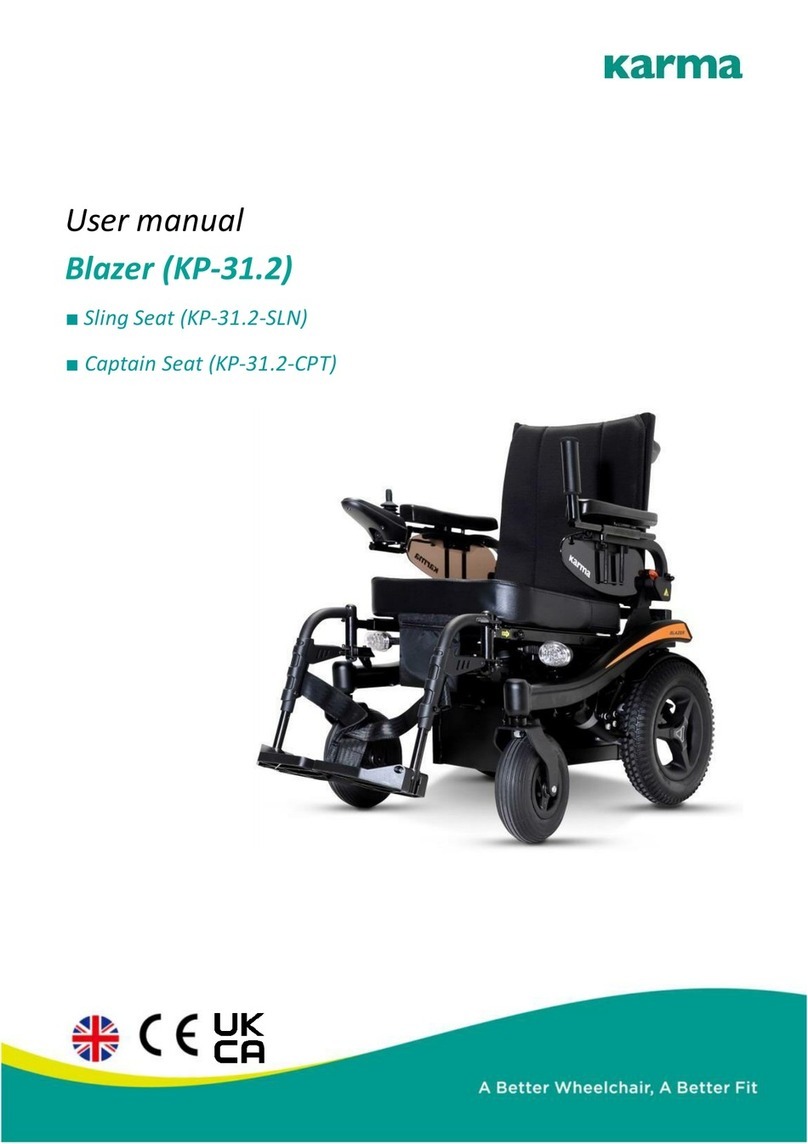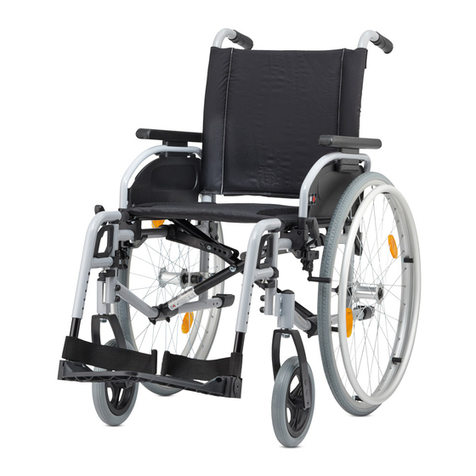BION KD User manual

KD, MWC, PL001 (01218)
Portable Power Wheelchair
Owner’s Manual

Contents
I. INTRODUCTION…………………………………………………………………………2
II. GUIDANCE FOR USE………………………………………..…………………………3
III. PRODUCT SAFETY SYMBOLS………………………… ………………………....4
IV. TECHNICAL SPECIFICATIONS………………… …………… ………………….5
V. FEATURES………………………………………………………………… …………..6
VI. ELECTROMAGNETIC INTERFERENCE WARNING……… ……… …………8
VII. SAFETY……………………………………………………………… ………… ……9
VIII. INSTALLATION GUIDE……………………………………… …………… ……16
IX. OPERATION GUIDE…………………………………………… ……… …………..18
X. BRAKING……………………………………………………… …………… ………..21
XI. BATTERY……………………………………………………… ……………… …...22
XII. UNFOLDING AND FOLDING………………………………… …………… ……..26
XIII. TROUBLESHOOTING………………. ………………………………… ………..30
XIV. WARRANTY……………………………… …………………………… ………….32
XV. PACKING LIST……………………………… ……… ……………… …………..34
1

Ⅰ.Introduction
Thank you for choosing KD’s Smart Chair, your effortless travel companion. Smart Chair is ultra-
compact, light-weight and portable allowing for comfortable travel, compact storage and increasing
accessibility in your daily life. Smart Chair is designed to fold in just seconds thus increasing travel
opportunities and allowing for compact storage. Smart Chair will allow you to go wherever and
whenever you choose!
Your safety is KD’s utmost priority. Please read and follow all instructions in this owner’s manual
carefully before operating your Smart Chair for the first time. For your own safety, it is crucial that
you completely understand the instructions given in this owner’s manual.
KD is not liable for any property damage or bodily injury which may occur as a result of improper
use of this power wheelchair or failing to follow the instructions in this owner’s manual.
If you have problem in comprehending the warnings and instructions contained in this manual,
please contact your distributor, or your provider or the manufacturer. We, at KD, strive to enrich
your life!
2

Ⅱ.Guidance for Use
This manual must be read and understood completely before your first use.
If you have difficulty in understanding the warnings, notes and instructions in this owner’s manual,
or require additional assistance, please contact your authorized provider or distributor to obtain
professional guidance and help. Failure to follow the instructions on this manual can lead to your
safety being at risk as result of improper usage, and voiding the warranty.
3

Ⅲ.Product Safety Symbols
The following symbols are used to identify warnings, mandatory actions and prohibited actions. It is
essential that you fully understand and completely familiarize yourself with these symbols before
operating Smart Chair for the first time.
Read and follow the instructions provided in this manual.
Safety warning sign or an indication of a dangerous operation that may endanger your
safety or the safety of others.
ClassⅠequipment (Canada) / ClassⅡequipment (USA).
Do not use any mobile phones, walkie talkies, electronic devices or any other radio
transmitters while operating.
Finger crush / pinch point.
Store in a clean and dry condition; away from rain, snow, ice, salt and water.
Test of EMI/RFI at an immunity level of 30 V/m has been passed.
Corrosive substance contained in the battery
Danger of explosion
Do not use batteries with different amp-hour (Ah) capacities, No mix use of old and
new batteries. Always replace both batteries at the same time.
Keep tools and other metal objects away from battery terminals. If contacted, short-
circuit or electric shock may occur and cause injury.
Flammable material, avoid exposure to heat source such as open flame or sparks.
Avoid transporting the batteries along with flammable or combustible objects.
Disposal and recycle
4

Ⅳ.Technical Specifications
General
Dimensions (Unfolded): L x W x H
39.37 x 26x 35.4in / 1000 x 660x 900 mm
Dimensions (Folded): L x W x H
12 x 26x 30 in / 305 x 660 x 760 mm
Suggested User Weight
Max: 253lbs (115kg)
GW/NW
56.43 lb (25.6kg) with battery /50.7
lb ( 23kg)
without battery
Maximum Climbing angle
12o(depend on user weight/safe climbing angle)
Full Charge Mileage
15km (vary with user’s weight, terrain, ground
condition, battery condition, temperature and
driving habit)
Max Speed
4.5km/h
Turning radius
35.4 in / 900 mm
Motor
Type
Brushless DC Motor
Rated power
180 W
Input Voltage
DC 24V
Qty
2 sets
Break System
Intelligent Electromagnetic Brake
Breaking Distance
At max speed: 0.5m
Battery
Type
Li-ion battery
Nominal Capacity
10 Ah
Output Voltage
DC 24V
Qty
2
Controller
Type
Brushless dual-drive rocker controller
Input Power
180W x 2
Input Voltage/Current
DC 24V/12A x 2
Front Caster
Size
8 in
Type
Solid Tire
Qty
2
Rear Wheel
Size
8 in
Type
Solid Tire
Qty
2
5

Ⅴ.Features
1. Upper Backrest
2. Back Cushion
3. Backrest joint
4.Armrest
5. Joystick
6. Lithium Battery
7. Safety belt
8. Seat Base
9.Leg Guard
10.Frame
11. Splash Guard
12.Motor Wheel
13.Footrest
14. Front Wheel
15.Storage Basket
6
1
3
11
6
14
2
4
3
5
12
9
7
8
10
15
13

Ⅴ.Features
16 .Folding Release Lever
17. Anti-Tipping Wheels
18.Electromagnetic Brake Levers
19.Control Panel Connector
20.Control Panel Cable Clip
7
16
17
18
19
20
19

Ⅵ.Electromagnetic Interference Warning
The power wheelchair may be affected by electromagnetic interference (EMI), which may cause
damage or interruption to the operation of the chair. It is important for you to understand the
instructions which can help you take protective measures against the risk of interference.
The sources of electromagnetic waves come from broadcasting stations, TV stations, radio
transmitters, two-way radios (such as walkie-talkies), cellular phones and computers. Interference
from these electromagnetic waves may cause malfunction or permanent damage to the chair’s
braking and control system.
CAUTION
1. The power wheelchair has passed the 30 V/m EMI test and has a certain degree of immunity
to most common electromagnetic energy sources. However, it is important for you to follow
the safety guidelines as follows:
a. Do not turn on or operate portable transceivers, receivers, radios or any wireless
communication devices.
b. Stay away from all radio wave emission sources.
2. If interference does occur and causes unintended movement to the chair in an uncontrolled
manner, cut off the power immediately.
3. No modification of any form to the power wheelchair is allowed, including adding or
removing any parts.
8

VII.Safety
Usage Safety Guidelines
Check all electrical and control connections to ensure they are secured safely and firmly.
Check battery levels regularly and ensure the battery is charged immediately when needed.
Keep tools and any metal objects away from the negative and positive poles of the battery.
Short-circuits or electric shock may occur when the two poles are accidentally contacted.
Familiarize yourself with Smart Chair and its capabilities.
Always seek assistance during your first use until you are confident enough to operate the
chair independently and proficiently.
Always beware of any potential danger while using the power wheelchair.
When the power wheelchair is not in use, turn off the power, charge the battery and store in
a clean and dry place.
Control Panel
To ensure your safety while operating the power wheelchair, the control panel must be securely
mounted (Fig. A1). If any buttons on the control panel fail or are not responding, you must stop
using the chair immediately and contact the provider for repair or replacement.
A1
9

VII.Safety
Static Position
When the chair is inactive even for a moment; the power must be off (Fig. A2). This will:
Prevent the control panel from being activated by accidental touch which may cause the
chair to move unintentionally.
Prevent the chair from electromagnetic interference sources which may activate the chair’s
operation system and cause damage to the chair and bodily harm.
Do not allow anyone but you to touch the control panel. This will protect the chair from being
moved without your awareness and causing potential serious bodily harm.
A2
Weather Precautions
This power wheelchair shall not be used or stored in environments of rain, snow, icy
or slippery surfaces. These conditions may adversely affect the
functions of the chair. Always keep your chair in a clean and dry area.
Malfunction may occur if the device is in contact with rain, snow or high humidity environments.
Do not expose the chair to any extremely hot or cold conditions. The chair is not fully waterproof; a
humid environment may result in rusting or corrosion inside the chair. If you are ever caught in any
of these conditions, please proceed to shelter immediately.
To prevent malfunction, please adhere to the guidelines as follows:
Do not operate or store the chair in an environment which has direct water contact;
extremely hot or cold temperature or high humidity.
Do not use the chair while showering, swimming, etc.
Do not use the chair in salt or fresh water
Do not use the chair around any water sources (e.g. rivers, lakes, etc.)
Do not flush the chair with water.
10

VII.Safety
Note: When the chair is wet, immediately pull out the battery and allow it to dry naturally. Put
the battery back after the chair is completely dried.
When operating on wet or frictionless ground surfaces, please carefully move at a slow speed and
follow the safety guidelines below:
When any of the motor wheels losses traction, the chair must be stopped immediately to
avoid losing control of the chair (e.g. slipping, tipping over, etc.).
Do not drive into slopes or ramps covered with snow, ice, water, oil, etc.
Road Surfaces
Smart Chair is designed optimally for dry level surfaces; such as concrete and indoor ground
flooring.
Do not use Smart Chair on sand, uneven or loose surfaces, tall grass or rough road surfaces to
prevent the wheels, bearings, axis, motor and other parts from being damaged or loosened.
Driving in Traffic Environment
It is at your own risk. Beware of the local traffic regulations. Be extremely cautious to your own
safety while driving on public roads.
For increased visibility at night, the chair has light reflecting markers attached to the chair (Fig. B1).
It is highly recommended that you wear light reflective clothing while driving at night.
When operating the chair in traffic amongst motor vehicles, is at your own risk. Keep
yourself within the sight of the driver and keep a safe distance. It is not recommended to
operate the chair in traffic.
B1
11

VII.Safety
Vehicle Transport
Please be aware that it is at your own risk and is not advisable to sit in the Smart Chair
when taking any forms of transportation such as cars, buses, trains, planes or ships.
If you must take such forms of transportation while remaining in the chair, it is extremely important
that you secure your positioning waist belt and power off the chair and push the brake lever to
“Lock” position, inspect no movement to the motor wheels and have the chair securely tied down.
This will help prevent injuries during sudden stops. However, as this chair is ultra-compact, taking
any transportation is made possible as you can fold the chair conveniently and can be stored away
in tight storage areas such as a car trunk. Please ensure the chair is stored securely in order to avoid
injury.
If you need to be transferred on or off a vehicle manually without getting off the chair, never allow
anyone to lift the chair by the armrest or rear backrest. The chair must be lifted by firmly gripping
the front and rear edges of the seat cushion frame.
Weight Distribution
To avoid tipping over while driving, the balance and stability of the power wheelchair must not be
neglected. The following factors may affect the weight distribution of the chair:
Height and angle of the chair.
Seating position, or weight loading position of the user’s body.
The gradient of the ramp or slope.
Load carried in storage basket or by the user may have adverse effects to the weight
distribution of the chair.
Do not modify or adjust Smart Chair’s configuration or construction yourself.
12

VII.Safety
Getting On/Off
Whenever moving your body, it is recommended to have a supporting point that is higher than the
seat cushion. To avoid and reduce the chance of falling, please be aware of the followings:
Before getting on and off the chair, ensure that you lift up the armrest and lower the leg
guard.
Before getting on the chair, ensure that the power is off and the brake is in “Lock” position.
Inspect that there is no movement to the motor wheels.
Before getting out of the chair, ensure that the power is off and the brake is in “Lock”
position. Inspect that there is no movement to the motor wheels. Move the chair as close as
possible to the target position to minimize the risk of falling during transfer.
Consult your health care professionals about the safest way to move your body in and out of
the chair.
Fold up the footrest at all times while getting on and off the chair
o Do not stand on the footrest to move your body while getting on/off the chair.
oMake sure your feet are not tangled or jammed in the gap between the footrest while
getting on/off the chair.
Leaning or Reaching while Seated
Reaching out your hands or leaning your body in the chair may adversely affect the chair’s balance.
If you do not position yourself correctly, you may fall off or tip over the chair.
When moving your body such as lifting your body at one side or leaving the seat, do not
lean your body out of the range of the seat cushion.
When moving forward on your seat, do not lean your body excessively. Your hip must be
always in contact with the seat cushion.
Do not reach your hands farther than your capability as this may result in falling due to lost
balance.
Under no circumstance should you try to pick up anything through the space between your
knees or in front of your body.
When you extend your body, do not exert force on the footrest to avoid the chair from
tipping over, this may result in serious injury.
Do not rest forcefully against the top of the backrest to avoid tipping over the chair and
causing damage to the backrest.
Failing to follow these guidelines may result in serious injury. If you do any of these
actions, it is at your own risk.
Never reach, bend, or lean in the chair. Doing so will change your center of gravity
and the weight distribution of the chair.
13

VII.Safety
Stationary Obstacles
Navigating over obstacles such as ramps, slopes, curbs, raised or uneven surfaces, pot holes and
rough roads can be hazardous. Extreme caution is needed to avoid tipping the chair over.
It is important to climb or descend an obstacle slowly, cautiously and perpendicularly. Failing to do
so may result in damage to the chair or causing bodily harm.
Do not exceed the incline guidelines and specifications in this owner’s manual.
To navigate over a stationary obstacle:
Approach the obstacle slowly, cautiously and perpendicularly.
With extreme caution, increase the forward speed gently when the front wheels just come in
contact with the obstacle and reduce the forward speed gently after the rear wheels cleared
the obstacle.
Lean your upper body slowly and slightly forward, when going over an obstacle with an
ascending slope.
With extreme caution, reduce the forward speed gently when the front wheels just come in
contact with the obstacle and increase the forward speed gently after the rear wheels cleared
the obstacle.
Lean your upper body gently against the backrest, when going over an obstacle with a
descending slope.
Avoid any sudden stops and starts.
Always navigate perpendicularly towards the obstacle.
Inclined Slopes
If you feel uncomfortable driving on a slope, do seek assistance to protect you from causing bodily
harm to yourself.
It is not advisable to drive on slopes over 10°.
It is prohibited to drive on slopes over 12°.
It is prohibited to drive on a wet slippery slope (e.g., snow, ice, water, oil).
It is prohibited to drive on slope if there are pits at the bottom of the slope.
It is prohibited to drive in areas with continuous up and down slopes
Reverse Driving
When driving in reverse, please exercise extreme caution. The motor wheels
may run into an obstructive object which may lead to your chair getting
out of control and may cause your chair to tip over.
All obstructive objects should be cleared and approach cautiously and slowly while driving
in reverse
Never drive in reverse on inclined slopes
14

VII.Safety
Load Limit
Max Load of the chair: 253lbs (115kg)
Do not exceed.
The safe load of the backrest: 165lbs (74.8kg)
Do not press down or lift up the backrest.
Under no circumstances should the user do weight training while using the chair.
Overloading the chair may cause damage to the chair’s frame, fastened parts and folding
device.
Overloading caused damages will void the warranty of the chair.
Getting Up/Down Stairs and Escalators
Smart Chair is not designed for long journeys or getting up and down stairs, and escalators
It is prohibited to move or use Smart Chair on stairs and escalators. Serious bodily
injury may result.
15
The Kick Stand Instruction
The Kick stand is located at the bottom of the
rear frame where red sticker shows。
Notice:
Only after folding wheelchair , the Kick
stand can be set upright, Before unfold the
wheelchair , set back kick stand horizontally
first .
Set back kick stand
followed by in the
direction
shown by arrow
Open the kick stand
in the direction
shown by the arrow
Only after folding , the kick stand can be set upright!
Before unfolding the wheelchair, set back kick stand
horizontally first. please don't adjust kick stand
length 。

VIII.Installation Guide
Positioning Waist Belt
The positioning waist belt is for holding your hip properly against the back of the seat and must be
strapped 45° over your hip (Fig. C) to prevent the user from falling off the chair. Please wear the
waist belt at all times while seated.
Please be aware that the waist belt is not intended for use as an auto style seat belt. The
Smart Chair is not designed for being used as a seat in any forms of transportation.
You must wear the seat belt provided in all forms of transportation.
You are at your own risk and are not recommended to use the chair as a seat when taking
any forms of transportation such as cars, buses, trains, planes or ships.
CAUTION
1. Always ensure the waist belt is appropriately installed onto the chair and adjusted securely
so that there is no snug, but also comfortable enough so that it does not interfere with your
breathing.
2. Always check the waist belt for any loose parts or wear and tear. If any problem is found,
contact your provider for maintenance or repair.
16

VIII.Installation Guide
Mounting the Control Panel
The control panel can be mounted on the right or left armrest. As shown in Fig. D1, put the quick
release clamp of the control panel onto the metal grab bar and lock the quick release handle tightly
and securely.
1. As shown in Fig. D2, route the control panel cable through the cable clip
D1 D2
2. As shown in Fig. D3, plug the four –pin control plug of the control panel into the socket at
either side.
D3
3. As shown in Fig. D4, there is connector for the control panel on the left and right side of the
chair. Please keep the dust cap of the unoccupied connector firmly closed at all times.
D4
17

IX.Operation Guide
Control Panels
The Control Panel comprises of the following:
③
⑤
①
⑧
⑥
④
②
⑦
Off
On
Number:
Function:
Description:
1
Power-On Button
Pressing this button will power on the chair.
2
Power-Off Button
Pressing this button will power off the chair.
3
Speed Button
Increase the speed of the chair
Max. speed: 6 km/hr (3.75 m/hr).
4
Speed Button
Decrease the speed of the chair.
5
Horn
Press horn to sound.
6
Battery Life
Indicate the battery level.
Indicator
7
Control Joystick
Control the direction and speed of the chair. Push the
joystick towards the desired direction.
8
Speed Indicator
With 5 LED lights on, the chair at its max. speed. 1
LED light on, the chair is at its lowest speed.
18

IX.Operation Guide
When the LED light flashes intermittently, which indicate specific diagnostic troubles referred in
the table below:
The lowest LED light flashes: Batteries are running low
The second LED light flashes: Joystick cannot deliver signals to the
control module
The third LED light flashes: Batteries are being charged.
Note: An electronic drive locking device is engaged to prevent the chair
from operating.
The fourth LED light flashes: Motor connection failed
The fifth LED light flashes: Electromagnetic braking disengaged
Control Joystick
When operating the chair for the first time, it is recommended to move the chair at a low speed
gently and gradually pushing the control joystick forward. The practice run will help you
familiarize yourself with controlling the speed and start and stop of the chair.
Do not do sharp turns at high speeds. The chair will lose its balance and tip over causing serious
bodily injury and property damage.
The control joystick on the control panel provides 360 degrees of omnibearing manoeuvrability
comfortably and effortlessly. A spring is equipped inside the joystick which automatically returns to
its original position when let go.
Push the joystick towards the target direction. The joystick can control the drive proportionally, the
harder the push, the faster it goes. The max traveling speed is 6km/hr.
Release the control joystick slowly and gradually for the chair to slow down safely. Sudden release
of the control joystick may cause the chair to lose balance and tip over causing bodily injury.
19
This manual suits for next models
2
Table of contents
Popular Wheelchair manuals by other brands

Everest & Jennings
Everest & Jennings Traveler L3 Plus 3F012 user manual

Nuprodx
Nuprodx MULTICHAIR BIG WHEEL Series ASSEMBLY & PACKING INSTRUCTIONS

Mopedia
Mopedia RS846 instruction manual
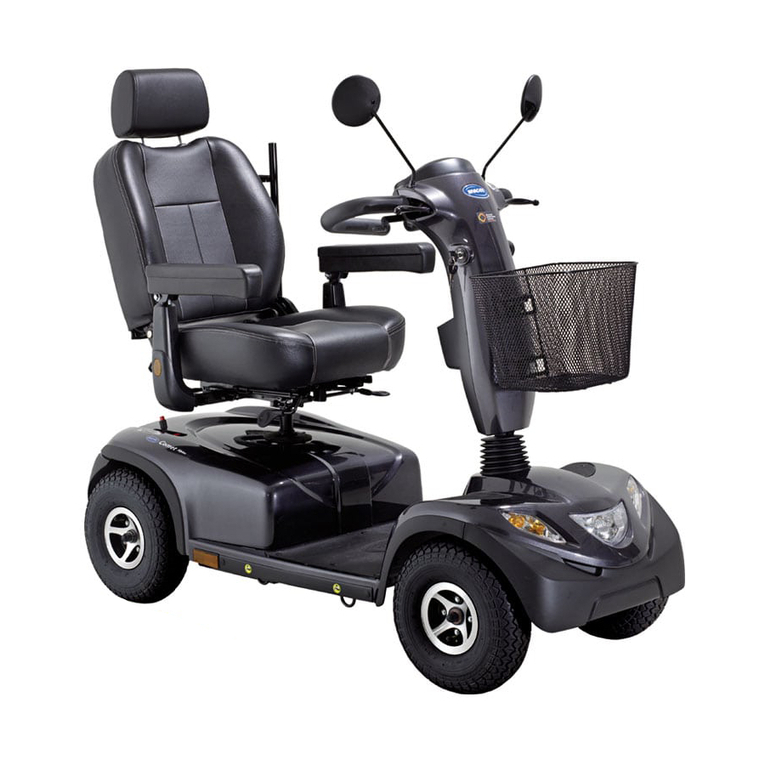
Invacare
Invacare Comet Owner's operating and maintenance manual

Invacare
Invacare rea azalea assist user manual
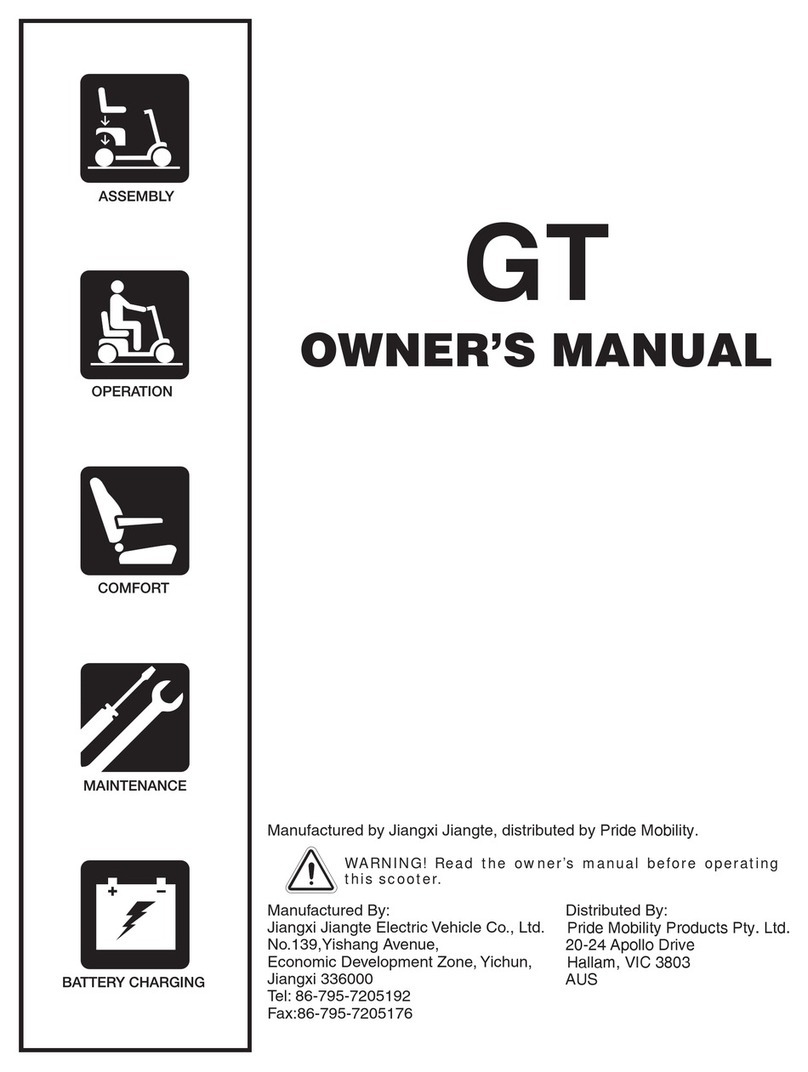
Pride Mobility
Pride Mobility GT owner's manual
